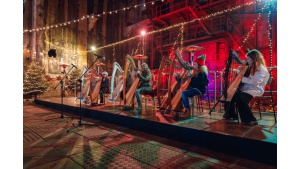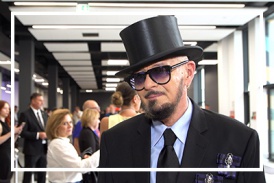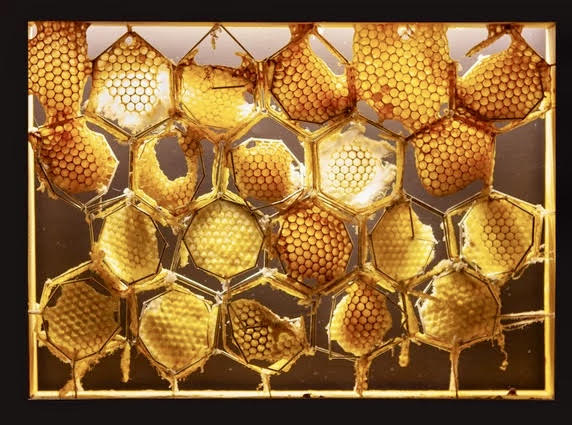Polish artist who creates together with ... bees
Magda Komar is a talented artist, and designer, specialising in fabrics and a lecturer of Textile Design at the Department of Fashion at the Academy of Fine Arts in Warsaw. Prominent fashion houses designers have used the unique designs of her fabrics, including brands such as Alexander Wang, Diane von Furstenberg, Escada and Chanel. In 2020, she started a unique artistic project called "The Practices of Coexistence", which is combined sculpture, installation and research experiment created in cooperation with another species - bees.
During the time of the pandemic, Magda first got acquainted with the basics of beekeeping, and then found beekeepers who helped her to get to know and understand the insects better. The result of this endeavour is an extraordinary collective work with input from both herself and the bees. Unique bas-reliefs describe modern world experiences and highlight the need to build a new relationship between man and nature, ecology, and even feminism and gender.
Interspecific cooperation of women
Albert Einstein argued that humanity would have survived for a maximum of four years if all bees had disappeared from the face of our planet. These little insects have a huge impact on our lives and play a fundamental role for in ecosystem. Honey bees, although they may not be aware of it, are also real artists. Magda works only with female bees, because it is impossible to deal with male drones because they are so lazy. So she jokes that it is a very feminine-feminine relationship.
Magda Komar learned about the extraordinary natural processes of wax formation and the history of traditional techniques drawing from the symbiosis between man and nature. An important part of this collaboration was constant contact with the bees. The artist peered into their world, engaging the senses - touch, hearing and smell. She even researched mythology, anthropological and philosophical texts about these insects. Finally, she bought a hive and introduced a bee family to it. She described these activities as "the physical process of constructing a new world”. The hive has become a kind of laboratory for her. She wanted to enter a relationship with bees, assuming the role of an "uneducated researcher" whose task is not to analyze these creatures scientifically, but to have a dialogue without specific expectations. A honey bee is an insect whose benefits are unique. Therefore, it is worth knowing what is in the hive and that each resident has a different task there.
- These creatures fascinate not only because of their diligence and how long their species lives, but also because of the fruit of their work: honey and the produced hexagonal forms, which we can also see in the ear of barley, on the turtle's carapace and in the cellulose cells of hornets' nests. In the eyes of ancient thinkers, bees forming honeycombs, always composed of hexagonal prisms, were considered the most perfect, by the divine hand of builders - says Magda Komar.
Works of art and ecology
No wonder that the artist was fascinated by the life of bees and the products of their painstaking work. It is a unique natural architecture that reflects potential interspecies dialogue - is it possible to reconcile a completely anthropological perspective with a project involving human-bee collaboration - a species that is still a mystery to us? Magda Komar emphasizes the need to part with the model based on the principle of human-nature struggle, and as the goal of her project, she describes the search for a symbiotic alternative and "going beyond yourself". As authors of the project, the artist mentions herself and the Bees - writing about them using a capital letter, because although the idea and initiative could have come from human hands, without the bee co-authors, nothing could have been created. The artist designed and created a series of hive frames, built using various techniques - from laser cutting and weaving.. She also made felt fabrics and nuno felt, creating ornamental forms from sewn metal jewelry tubes, pouring beeswax on felt and silk to invite bees to join them. In this way, "The Practices of Coexistence" were created, works that are a story about symbiosis, human dialogue with other species, with nature, of which we ourselves are a part.
- Bees have become sculptors while struggling with everyday life - reproduction and efforts to ensure the well-being of their offspring. Now, looking at it from a distance, I would say that it was an exchange between us women - artists, mothers, feeders, gatherers, waxers, warehouse workers, fans, females. It was a very feminine relationship. In the world of bees, as in the world of women, responsibility and care for others are involved in their work - artistic activities - says Komar.
Magdalena Komar is a graduate of the oldest fashion school in the world - Paris ESMOD, which she graduated with a special award from Michèle Lemaire. Founded in 1841 by Alexis Lavigne, the personal tailor of Empress Eugenia, wife of Napoleon III, who invented the tailor's tape measure and was the first to use wooden mannequins. After studying in Paris in 1997–2000, she worked as a costume designer in film and television theater. Until 2003, she also studied at the Multi Media Textiles department at Loughborough College of Art and Design, then started her own business. She started with luxurious scarves and foulards that were sold in Paris and London under the “MAGDALENA” brand. Since 2005, Komar has been creating modern embroideries, applications and patterns for materials for the prêt-à-porter and haute couture collections. Her projects are bought by, among others Chanel, Fendi, Donna Karan, Alexander Wang, Zac Posen, Diane von Furstenberg, Kenneth Cole, J. Crew, Isa Seta, Kate Spade, Calvin Klein Home, Banana Republic, and Victoria's Secret. Since 2010, she has been running the Material Science and Textile Design Studio at the Department of Fashion at the Academy of Fine Arts in Warsaw.

Sztuka współczesna w Muzeum Warszawy: ścieżka Sztuka wspierania

Koncert Świąteczny w zabytkowej Elektrowni

NOWY PROJEKT CYFROWY - DIGITALIZACJA DÓBR KULTURY WROCŁAWIA
Więcej ważnych informacji
 Jedynka Newserii
Jedynka Newserii

 Jedynka Newserii
Jedynka Newserii

Media

Tomasz Jacyków: W tym sezonie w Polsacie jest dużo „spadochroniarzy” z innych stacji. Ja nie oglądam telewizji w ogóle
Co prawda stylista zaznacza, że nie ogląda telewizji, ale pojawił się na prezentacji jesiennej ramówki Polsatu. To dla niego okazja, by nie tylko samemu się pokazać na ściance w nietuzinkowym stroju, ale także podejrzeć, co pozostali postanowili na siebie założyć. Tomasz Jacyków zauważa też, że do stacji dołączyły niedawno nazwiska wcześniej kojarzone z innymi kanałami, jest więc ciekawy, jakie będą efekty tej współpracy.
Konsument
Nieprawidłowe postrzeganie masy ciała może być przekazywane pokoleniowo. Ważne jest budowanie zdrowych nawyków na poziomie rodziny

Rodzice przekazują swojemu potomstwu własne lęki, w tym te dotyczące postrzegania własnego ciała – mówią psychodietetycy. Przez naśladownictwo dzieci uczą się też nieprawidłowych nawyków żywieniowych, takich jak na przykład kompulsywne objadanie się po niepowodzeniu w stosowaniu restrykcyjnej diety. Eksperci podkreślają, że podstawą profilaktyki zaburzeń odżywiania jest uświadamianie dzieci na temat zdrowych nawyków. Zachęcają do wspólnych zakupów i przygotowywania razem posiłków. Ostrzegają również przed fat shamingiem, którego konsekwencje mogą towarzyszyć dziecku również w dorosłości.
Gwiazdy
Cezary Pazura: Siatkówka to nasz sport narodowy, bo naprawdę nam wychodzi. Podczas studiów byłem mistrzem w tej dyscyplinie

Aktor przyznaje, że jest wielkim pasjonatem siatkówki, stara się oglądać wszystkie rozgrywki reprezentacji i czuje ogromną satysfakcję oraz dumę, kiedy nasi zawodnicy wygrywają kolejne mecze. Podczas studiów Cezary Pazura sam zdobył tytuł najlepiej rozgrywającego turnieju, dobrze więc wie, jakich emocji dostarcza sport i rywalizacja. Z całych sił zachęca więc swoje dzieci do aktywności fizycznej, by znalazły ulubioną dyscyplinę i trenowały.









 |
| |
| |
|